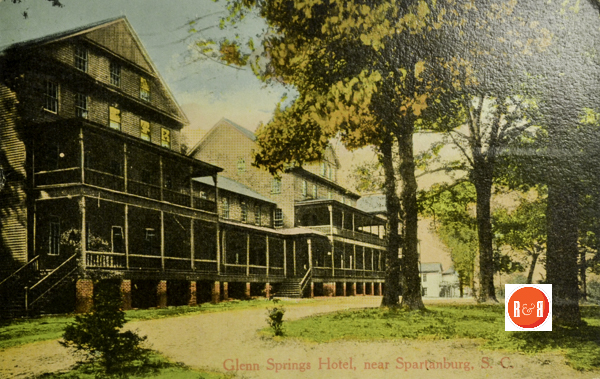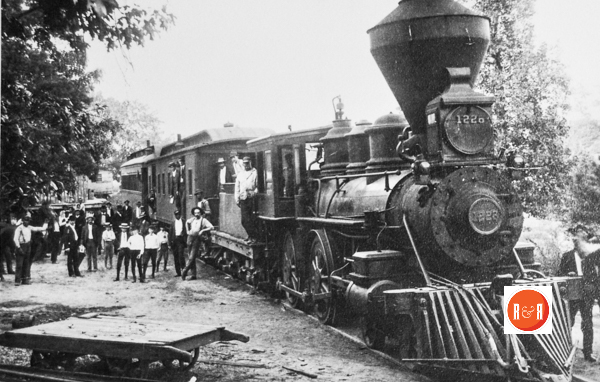The Yorkville Enquirer reported on June 25, 1885 – “A narrow gage railroad will be built from Spartanburg to Glenn Springs at a cost of $35,000.”
City Directories and History: “Glenn Springs, twelve miles southeast of Spartanburg, is the most notable former health spa in the county. It is named for John D. Glenn, who bought 500 acres in the early 1800’s on
which the spring was situated. Glenn improved the property, and in 1835 sold it to a stock company, chartered in 1837 as the Glenn Springs Company, with Dr. Maurice A. Moore as president. For over a century, the spring with its large frame hotel, was a mecca for Low Country folk seeking relief from “summer sickness,” now known as malaria. The property is at present the location of Spartanburg Boys Home.”

Image courtesy of the Willis Collection – 2016 – Revolutionary War soldiers discovered that if they bathed in a certain spring located on the Means Plantation they were cured of the “itch.” Since such problems were common to frontier living, the spring became quite popular. In 1816 Means sold the spring and surrounding lands to John B. Glenn, who intended to build a house to board summer visitors. In 1845 what had become known as Glenn Springs was purchased by John Conrad Zimmerman, under whose keen guidance the hotel was built, and the area became one of the most popular vacation spots in South Carolina. Even at this early date the water was bottled and sent to eager customers all over the Southeast. The hotel burned in 1941. Pictorial History of Spartanburg County by Philip N. Racine – 1980
Information from: Names in South Carolina by C.H. Neuffer, Published by the S.C. Dept. of English, USC
The history of the Glenn Springs community focuses around the reputation of the mineral springs for their medicinal value and the related development of a resort hotel. At least by the early nineteenth century, the waters of Glenn Springs, which was then 1 called Sulphur Spring, were believed to help cure maladies such as rheumatism and agues. In 1827 John B. Glenn purchased a 723-acre tract of land which included the springs, and according to tradition, he opened an inn and built several log cabins

Visitors to Glenn Springs, ca. 1910’s. Courtesy of the Davie Beard Collection – 2017
to rent near the spring. The area became known as Glenn’s Spring or Glenns Springs and eventually Glenn Springs. The Glenn Springs Company purchased the land from Glenn and was granted a charter in 1837. Dr. Maurice A. Moore, a Union District planter, was a prominent member of the company. The Glenn Springs Company constructed a large wood frame hotel with landscaped grounds and cottages which opened ca. 1838. The venture was unsuccessful, and the property was sold at a sheriff’s sale in February 1842. John C. Zimmerman purchased a partial interest in the property in 1842; he obtained full ownership in 1844 and managed the hotel until ca. 1853. Ownership of the Glenn Springs Hotel subsequently changed hands numerous times. With the development of the hotel, Glenn Springs became a fashionable upcountry resort frequented by South Carolina politicians, educators, soldiers, planters, and their families. Arriving on 29 August 1860, Samuel Edward Burges reported that there were seventy or eighty guests at Glenn Springs. His days were spent “loafing” in the store and billiard room, playing ten pins, and making walks to the springs; tableaux were presented after dinner. By the 1860s a community had grown up around the hotel. According to tradition, Maurice Moore had moved a house (Cedar Grove, #9) to the area around the time the Glenn Springs Company was formed; he continued to live in the community after the company was liquidated. In 1842 John Zimmerman and the other owners of the Glenn Springs property, in an effort to increase the value of the tract, had decided to build a school to encourage families with children to purchase lots and settle there. Several lots were sold and a school building was constructed. Zimmerman had purchased a three-acre lot in 1842 and had built his fine Greek Revival house ca. 1854. There was also a store, a post office, and an Episcopal church In the late nineteenth century Glenn Springs, which included a large frame hotel with sixty sleeping compartments in addition to ten cottages, continued to be a popular resort. On 27 August 1884 Maj. John P. Kinard of Newberry reported that there were about “250 [guests] of all sorts, old and young, and many distinguished gentlemen and ladies of this and other States.” The hotel register for the years 1895-1897 reveals that, although most guests were from South Carolina, the clientele included visitors from Virginia, West Virginia, North Carolina, Maryland, Texas, Michigan, and Washington, D.C Guests made early morning and late afternoon strolls to the spring (Pavilion and mineral spring site, #16). There were also amusements such as billiards, ten pins, croquet, cards, and dances….. (NR File Data / S.C. Dept. of Archives and History)
Mr. William Kelly of Union Co., S.C. visited the resort in 1856 remaining sixteen days. He paid a total of $35.55 for himself, a servant and horse. Receipt signed for by S.L. Leaphart, clerk.
Revolutionary War soldiers discovered that if they bathed in a certain spring located on the Means Plantation they were cured of the “itch.” Since such problems were common to frontier living, the spring became quite popular. In 1816 Means sold the spring and surrounding lands to John B. Glenn, who intended to build a house to board summer visitors. In 1845 what had become known as Glenn Springs was purchased by John Conrad Zimmerman, under whose keen guidance the hotel was built, and the area became one of the most popular vacation spots in South Carolina. Even at this early date the water was bottled and sent to eager customers all over the Southeast. The hotel burned in 1941.
Pictorial History of Spartanburg County by Philip N. Racine – 1980
Stay Connected
Explore history, houses, and stories across S.C. Your membership provides you with updates on regional topics, information on historic research, preservation, and monthly feature articles. But remember R&R wants to hear from you and assist in preserving your own family genealogy and memorabilia.
Visit the Southern Queries – Forum to receive assistance in answering questions, discuss genealogy, and enjoy exploring preservation topics with other members. Also listed are several history and genealogical researchers for hire.
User comments welcome — post at the bottom of this page.
Please enjoy this structure and all those listed in Roots and Recall. But remember each is private property. So view them from a distance or from a public area such as the sidewalk or public road.
Do you have information to share and preserve? Family, school, church, or other older photos and stories are welcome. Send them digitally through the “Share Your Story” link, so they too might be posted on Roots and Recall.
Thanks!









